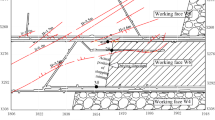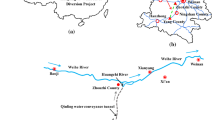Abstract
Several decades of faulty exploitation of salt through solution mining led to the creation of an underground cavern containing several million cubic meters of brine. To eliminate the huge hazard near a densely inhabited area, a technical solution was implemented to resolve this instability concern through the controlled collapse of the roof while pumping the brine out and filling the cavern with sterile. To supervise this, an area of over 1 km2 was monitored with a staggered array of 36 one-component, 15 Hz geophones installed in 12 boreholes about 160–360 m deep. A total of 2,392 seismic events with M w −2.6 to 0.2 occurred from July 2005 to March 2006, located within an average accuracy of 18 m. The b-value of the frequency-magnitude distribution exhibited a time variation from 0.5 to 1 and from there to 1.5, suggesting that the collapse initiated as a linear fracture pattern, followed by shear planar fragmentations and finally a 3-D failure process. The brunching ratio of seismicity is indicative of a super-critical process, except for a short period in mid-February when temporary stability existed. Event relocation through the use of a collapsing technique outlines that major clusters of seismicity were associated with the main cavern collapse, whereas smaller clusters were generated by the fracturing of smaller size nearby caverns. It is shown that one-component recordings allow for stable and reliable point source event mechanism solutions through automatic moment tensor inversion using time domain estimates of low frequency amplitudes with first polarities attached. Detailed analysis of failure mechanism components uses 912 solutions with conditional number CN < 100 and a correlation coefficient r 2 > 0.5. The largest pure shear (DC) components characterize the events surrounding the cavern ceiling, which exhibit normal and strike-slip failures. The majority of mechanism solutions include up to 30% explosional failure components, which correspond to roof caving under gravitational collapsing. The largest vertical deformation rate relates closely to the cavern roof and floor, as well as the rest of the salt formation, whereas the horizontal deformation rate is most prominent in areas of detected collapses.















Similar content being viewed by others
References
Aki, K. and Richards, P.G., Quantitative Seismology: Theory and Methods (W.H. Freeman, San Francisco, 1980).
Dufumier, H. and Rivera, L. (1997), On resolution of the isotropic component in moment tensor, Geophys. J. Int. 131, 595–606.
Frohlich, C. (2001), Display and quantitative assessment of distributions of earthquake focal mechanisms, Geophys. J. Int. 144, 300–308.
Helmstetter, A. and Sornette, D. (2002). Sub-critical and super-critical regimes in epidemic models of earthquake aftershocks, J. Geophys. Res. 107, 2237–2257.
Hudson, J.A., Pearce, R.G., and Rogers, R.M. (1989), Source type plot for inversion of the moment tensor, J. Geophys. Res. 94, 765–774.
Jones, R.H. and Stewart, R.C. (1997). A method for determining significant structures in a cloud of earthquakes, J. Geophys. Res. 102, 8245–8254.
Jost, M.L., and Herrmann, R.B. (1989), A student’s guide to and review of moment tensors, Seism. Res. Lett. 60, 37–57.
Kostrov, B.V. and Das, S., Principles of Earthquake Source Mechanics (Cambridge University Press, Cambridge, UK, 1988).
Press, W.H., Flannery, B.P., Teukolsky, S.A., and Vetterling, W.T., Numerical Recipes: The Art of Scientific Computing (Fortran Version) (Cambridge University Press, Cambridge UK, 1989).
Riznichenko, Y.V., Seismic rock flow, In Dynamics of the Earth Crust, Nauka, Moskow (in Russian), 1965.
Trifu, C-I., Angus, D., and Shumila, V. (2000). A fast evaluation of the seismic moment tensor for induced seismicity, Bull. Seismol. Soc. Am. 90, 1521–1527.
Trifu, C-I. and Shumila, V. (2002), The use of uniaxial recordings in moment tensor inversions for induced seismic sources, Tectonophysics 356, 171–180.
Trifu, C-I. and Shumila, V. (2005). Seismic hazard assessment in mines using a marked spatio-temporal point process model, In Controlling Seismic Risk (eds. POTVIN, Y., and HUDYMA, M.), Australian Centre for Geomechanics, Perth, Australia, pp. 461–467.
Vavrycuk, V. (2001), Inversion for parameters of tensile earthquake, J. Geophys. Res. 106, 16339–16355.
Zamfirescu, F., Mocuta, M., Constantinescu, T., Nita, C., and Danchiv, A., The main causes and processes of instability evolution at Field II of Ocnele Mari – Romania, In Proc. Solution Mining Research Institute Spring Meeting, 28 April – 2 May, 2007a, Basel, Switzerland, 6 pp.
Zamfirescu, F., Mocuta, M., Dima, R., Constantinescu, T., and Nita, C., A technical solution for the collapse fragmentation of the Field II cavern – Ocnele Mari, Romania, In Proc. Solution Mining Research Institute Spring Meeting, 28 April – 2 May, 2007b, Basel, Switzerland, 8 pp.
Acknowledgments
We acknowledge Ervin Medves (ERM SRL) and Florian Zamfirescu (Universitatea Bucuresti) for their efforts towards the implementation of the passive microseismic monitoring technology at Ocnele Mari. Alexandru Danchiv, Monica Andrei, Marius Mocuta (Universitatea Bucuresti), Valentin Filip, Marius Mateica (S.C. FlowTex Technology SA), Ian Leslie and Mike Smith (Engineering Seismology Group Inc.) are acknowledged for their sustained contribution to the maintenance of the microseismic system. Additionally, we would like to thank Florian Zamfirescu and Alexandru Danchiv for various discussions on technical aspects related to this project.
Author information
Authors and Affiliations
Corresponding author
Rights and permissions
About this article
Cite this article
Trifu, CI., Shumila, V. Microseismic Monitoring of a Controlled Collapse in Field II at Ocnele Mari, Romania. Pure Appl. Geophys. 167, 27–42 (2010). https://doi.org/10.1007/s00024-009-0013-4
Received:
Revised:
Accepted:
Published:
Issue Date:
DOI: https://doi.org/10.1007/s00024-009-0013-4




